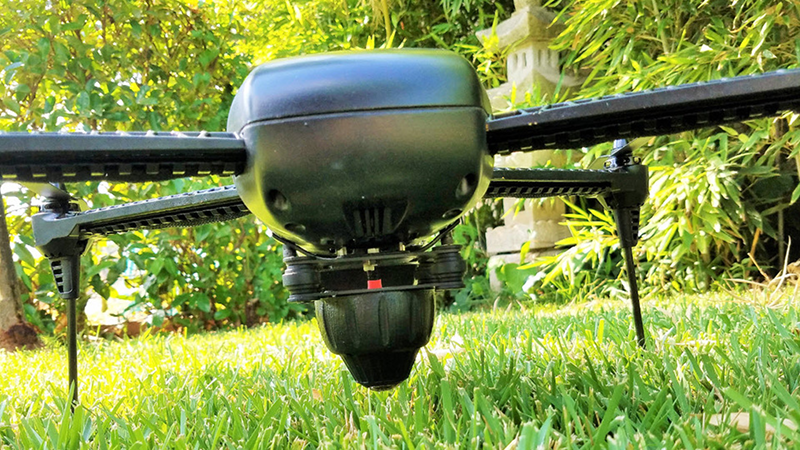One of the problems with a cheap drone is getting good video, especially in real time. Cheap hobby quadcopters often have a camera built-in or mounted in a fixed position. That’s great for fun shots, but it makes it hard to get just the right shot, especially as the drone tilts up and down, taking the camera with it. Pricey drones often have a gimbal mount to keep the camera stable, but you are still only looking in one direction.
Some cheap drones now have a VR (virtual reality) mode to feed signal to a headset or a Google Cardboard-like VR setup. That’s hard to fly, though, because you can’t really look around without moving the drone to match. You can mount multiple cameras, but now you’ve added weight and power drain to your drone.
MAGnet Systems wants to change all that with a lightweight spherical camera made to fit on a flying vehicle. The camera is under 2.5 inches square, weighs 62 grams, and draws less than 3 watts at 12 volts. It picks up a sphere that is 360 degrees around the drone’s front and back and 240 degrees centered directly under the drone. That allows a view of 30 degrees above the horizon as well as directly under the drone. There is apparently a different lens that can provide 280 degrees if you need that, although apparently that will add size and weight and be more suitable for use on the ground.
The software (see video below) runs on Windows or Android (they’ve promised an iOS version) and there’s no additional image processing hardware needed. The camera can also drive common VR headsets.
The device is set to go on sale later this year with no word on the price. You can mount multiple GoPro cameras if you can afford the weight, but this seems much more practical both from a weight perspective and doesn’t require software stitching. There are other panoramic cameras like the iris360, the LG 360, the Theta S, and the Gear 360. None of those look optimized for use on a drone, though. This looks more competitive with the 360 Fly or the Viooa. There are many others, too, some of which never got off the ground (no pun intended).
We’ve seen wide field of view cameras mounted to heads before. While it might be heavy, you can pull off a full sphere with only two cameras. Even NASA has been working on spherical flight video.
https://www.youtube.com/watch?v=tKD3U6ONK5Q
Thanks [Evan] for the tip.















Hmm since for the most part most multirotar whoozles have no “front” with the exception of some tricopters. I wonder how difficult it would be to link the software in such a way that it could redefine forward to be wherever you are immediately looking.
This should be a solved problem. Even thought that this takes 360 video, the operator’s current viewpoint could be controlled the same way a camera gimbal on a quad is currently controlled.
And if not, I would think you can almost certainly back out the quad’s motion via SLAM. Combining that with the recorded IMU data should give a very accurate estimate.
Maybe add some software that controls the drone from the spherical image. Allowing you to navigate the area beyond the original capture.
Possibly incorporating the sort of output given by the hyperdimensional video that was on here a while back to map where the drone has been. Perhaps multiple drones that fly in self organised formation gathering telemetry ahead of the user. The user then has a layer above that and cannot usually see the drones input directly.
It would be great for game designers. [ until the military cottons on ]
Okay, you got me; I tried searching for “hyperdimensonal video hackaday” on el Google and could only find your comments on various videos suggesting that the article ‘thing’ would be great on the aforesaid “hyperdimensonal” video. So what are you talking about?
(the closest I could get to was the “hyperlapse” demo by a microsoft research team)
Were you thinking of some depth data along with the above to create a “live” 3-d environment that could be navigated independent of the drone(s)?
Maybe he meant hyperspectral video?
Software image stabilization would be a great addition (when “inside” the sphere of course)
The problem with these things is they use a fisheye lens on a standard HQ or QHD image sensor, so for example a normal camera records with a 60 degree field of view. If you put a 180 degree fisheye lens on it then you have 9 times as much visible field of view in comparison, but it is recorded in the same resolution, so every pixel has 9 times less resolution than the 60 degree camera. You get 9 times more detail with the narrower lens.
Of course, but many-megapixel cameras are cheap enough to throw away nowadays, so there’s resolution to spare. This is very worth it! Might be there’s still more resolution than you can fit on your screen.
Fatfingered the report button again. HAD, would you please add dialog to ask for a reason to allow cancellation?
Wouldn’t the addition of a fisheye lens prevent using the captured images to build 3D models?
Quick Google shows that Photoshop apparently has a de-fisheye function. There must be some simple-ish function you can put images through to correct them. There’s probably some Linux thing that does it from the shell.
A C130 or similar transport aircraft is significantly slower than a fighter jet
The whole “Mission truck” idea has existed since 2004 when the B1-R concept was developed (https://www.youtube.com/watch?v=FFsYcK5lWrQ)
Basically a huge circle of defense contractor “give us money”
China is developing a drone which fly with 1 human.